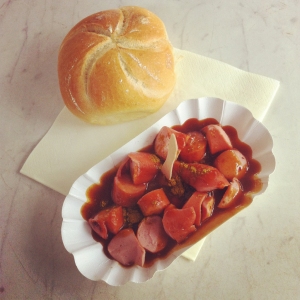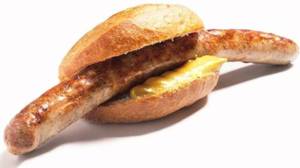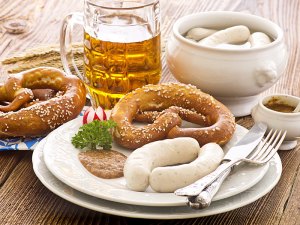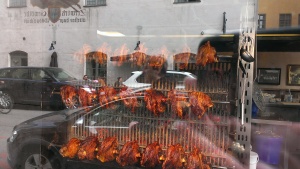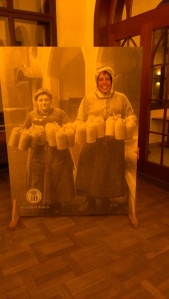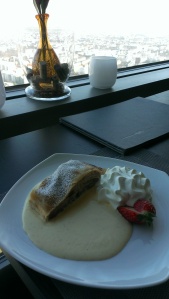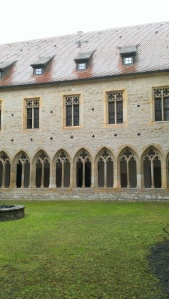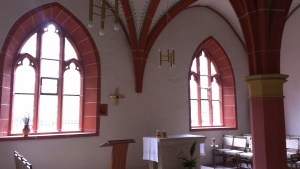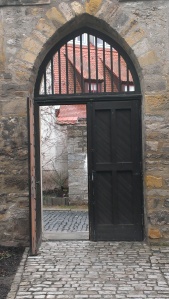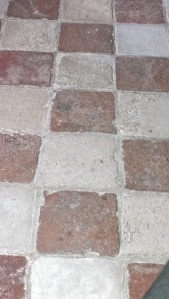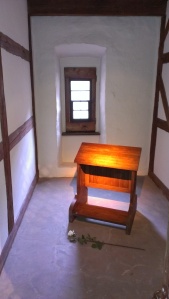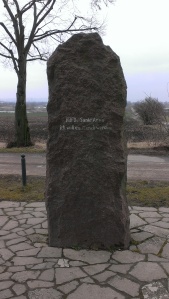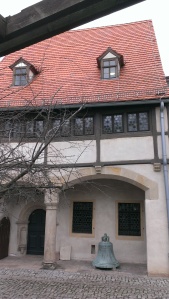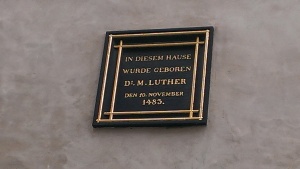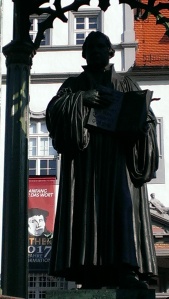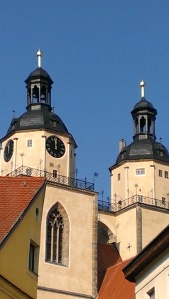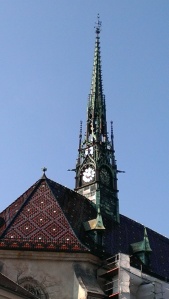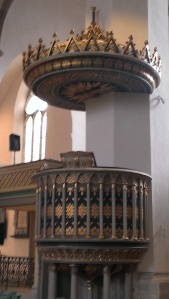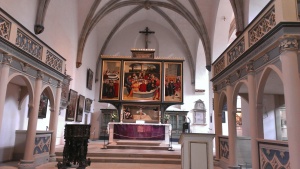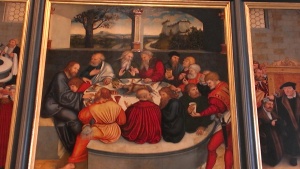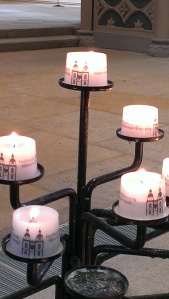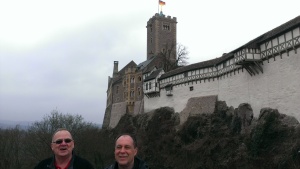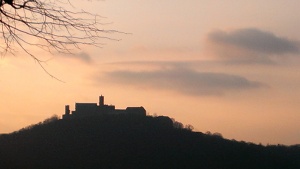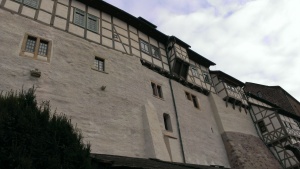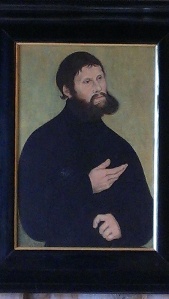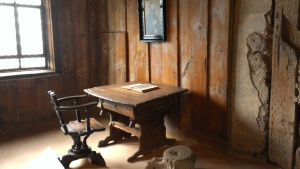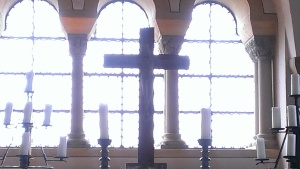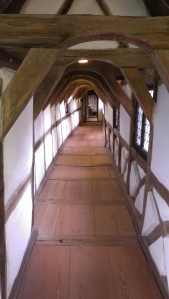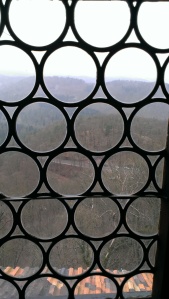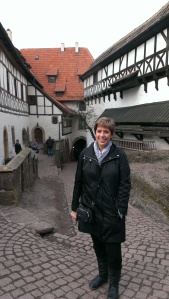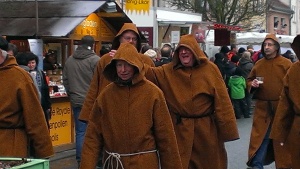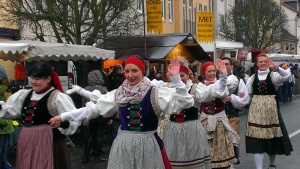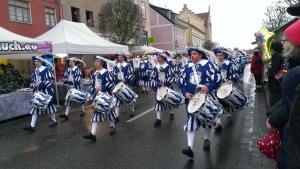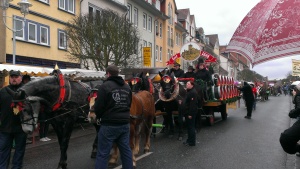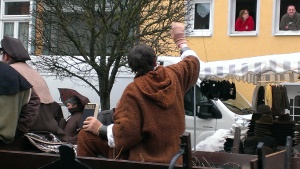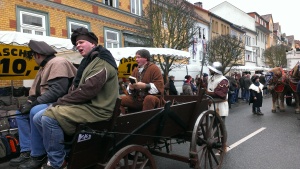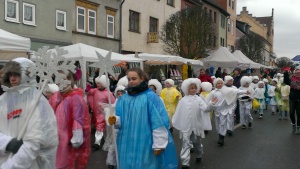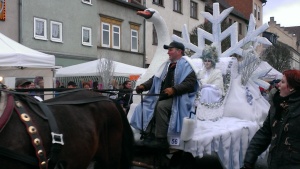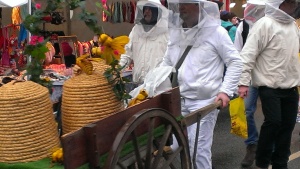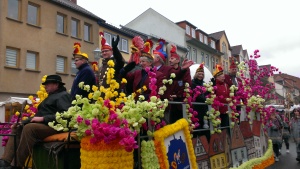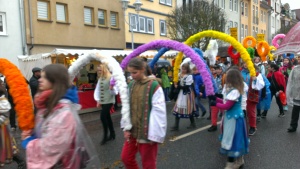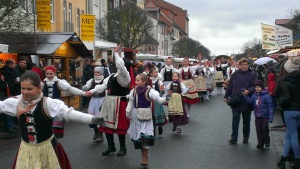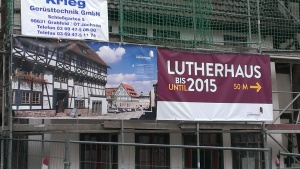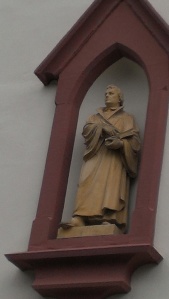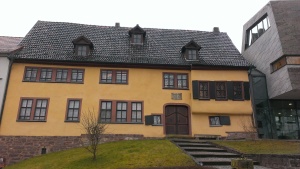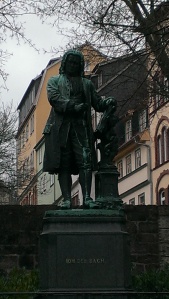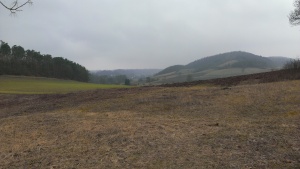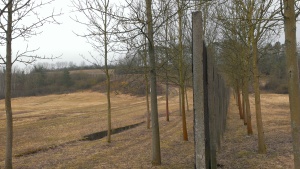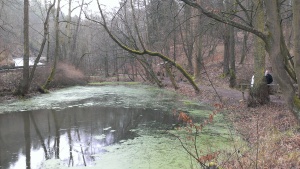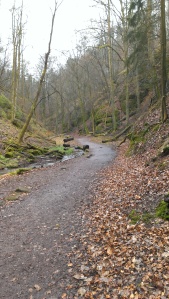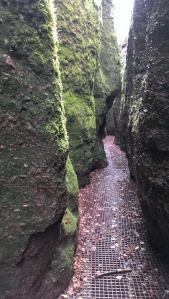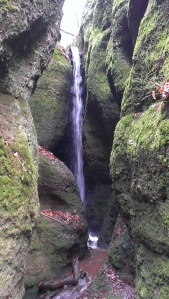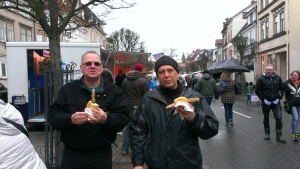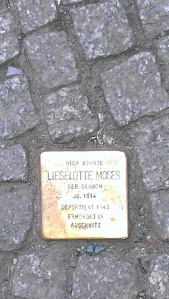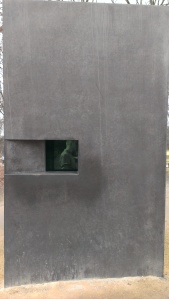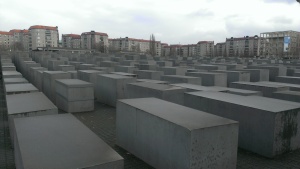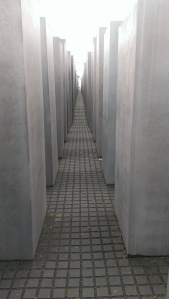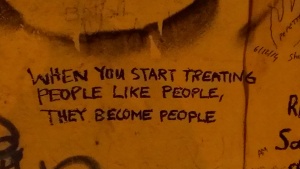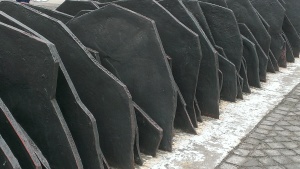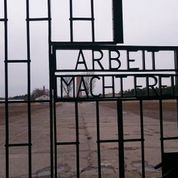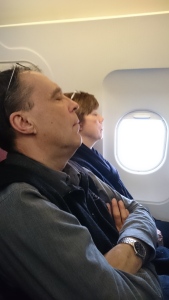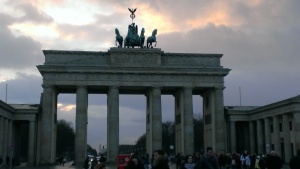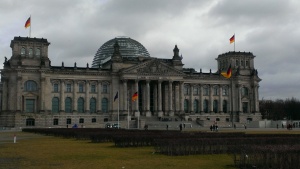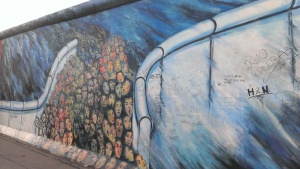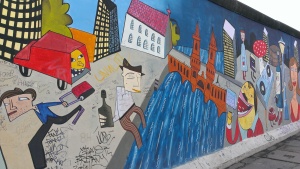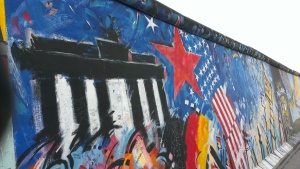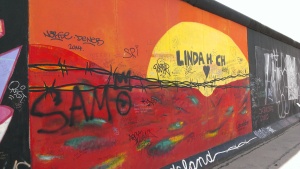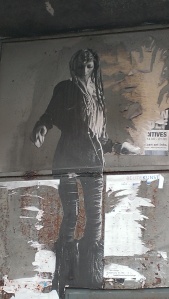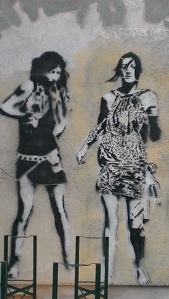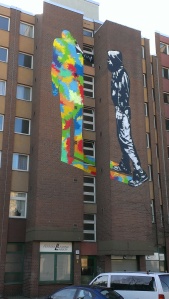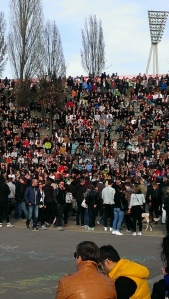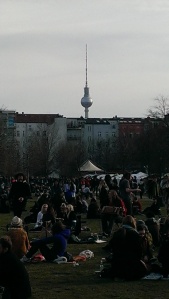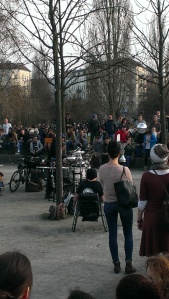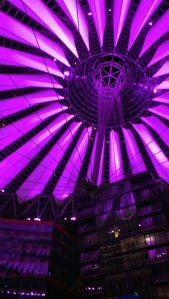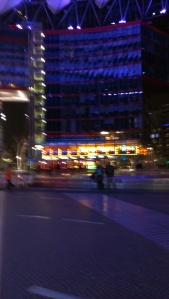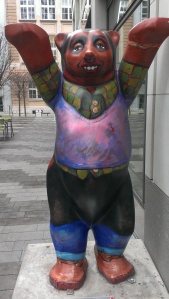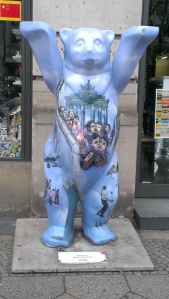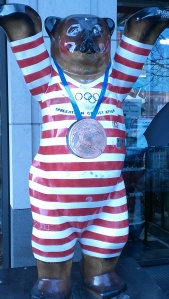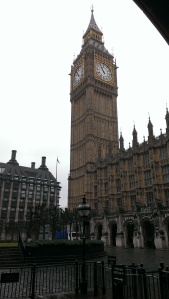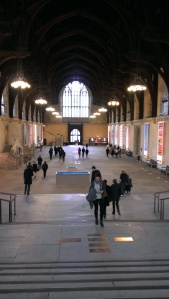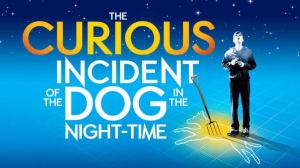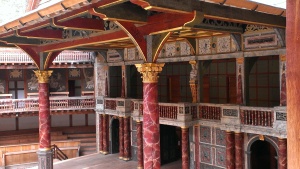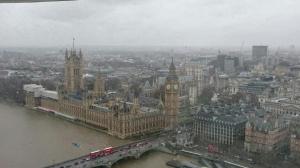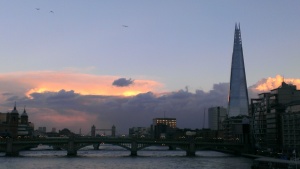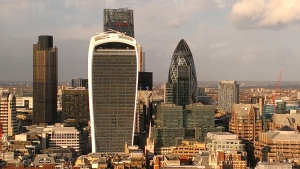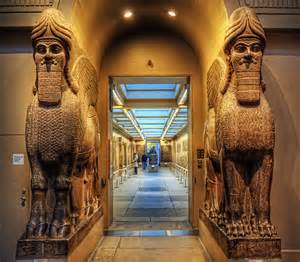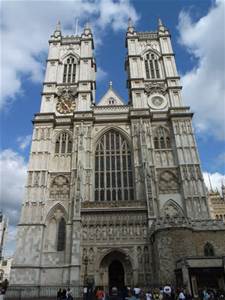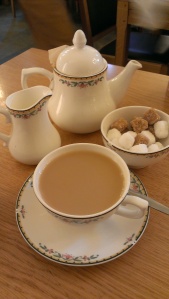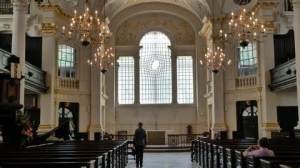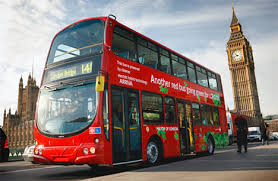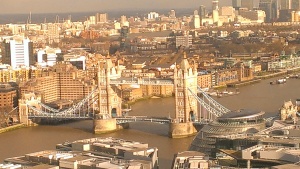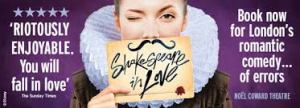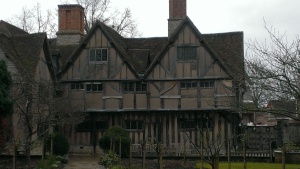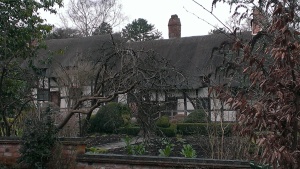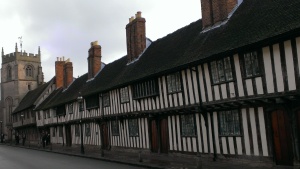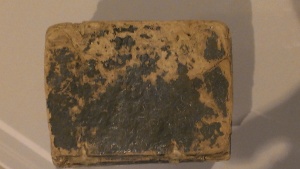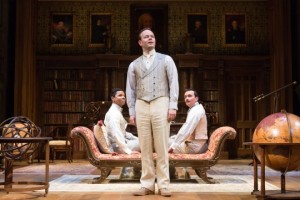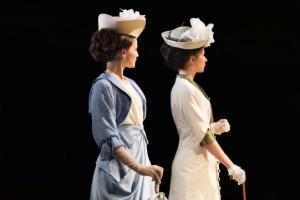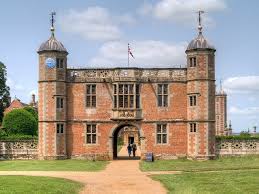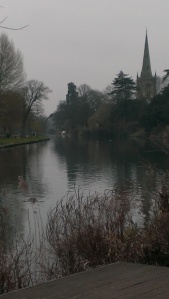One thing I loved about Germany was tasting the sausages. Every region had its own specialty. Berlin had currywurst—sliced sausage in a red curry sauce. Eisenach had Thuringer sausage, a sort of super-sized bratwurst served on an undersized bun (just big enough to hold the sausage in one hand without getting messy!). Munich had a white veal sausage, weisswurst, that was served primarily in the morning (often with a wheat beer), brought to the table in a huge terrine filled with boiling water to keep the sausages hot.
Pork was definitely a mainstay in the German diet (I think we must have eaten our body weight in it while we were there), but there was one dish that stood out among the many we tried: roasted pork knuckle. Seeing knuckles roasting in a window was all it took to get us past the thought of what we were actually eating to try this German treat. And oh, what a wonderful treat! The roasted cracklings are an indulgence beyond decadent, and the steaming meat inside is roasted to perfection. Pork knuckle, we decided, was the meal of travel champions! Washed down with a nice pilsner and accompanied by a fresh-baked pretzel, there couldn’t be a finer meal.
If I ever need a second career, it could easily be barmaid in a German beer garden.
There’s something to love about German cuisine (don’t even get me started on the custom of afternoon strudel!).
At this point, you may be thinking that all we did was eat . . . but we actually did manage to squeeze some sight-seeing in between meals.
After we left Weimar, we went on a blitz of Luther sites, starting with the monastery where he was trained and ordained. We arrived on a Sunday morning just in time for worship in the small chapel, which in Luther’s time had been the place where novices received their robes, had their hair shaved in the tonsure style of monks, and took their vows. How amazing to think that Luther himself had knelt on the floor stones beneath us as he began the journey that would lead him to become one of the most renowned theologians of all time.
You’ll see that with my new German haircut I fit right in to the monastic scene (and no, I’m not going to say whether I had a tonsure or not . . . you’ll just have to guess . . . but do ask me about the experience of getting a haircut in a country where I couldn’t speak the local language . . . that was an adventure!).
The service at the Monastery was in German, of course, but it had the familiar feel of a comfortable shoe—the cadence of the Lutheran liturgy is universal. Luckily, the hymn tunes were all familiar, so we could sing along . . . and nobody gave us the stink-eye for our less than perfect pronunciation.
People were remarkably friendly, sharing their hymnals with us and helping us find our way through the communion procession without causing a traffic jam. The pastor was very attentive to us as guests, and made us feel very welcome indeed. And—the best thing of all was that the pastor was a woman! How wonderful to see so clearly the seeds of reformation that Luther planted so long ago still bearing fruit for a changing and vibrant faith today!
We had a big travel agenda, so we didn’t have time to explore the Erfurt further (a good reason to go back someday). Instead, we set our course for Eisenach, Luther’s birthplace and also the place where he took his last breath (and preached his last sermon).
Just outside of Erfurt, we stopped to see the Luther Stein (or stone) that marked the spot where the Reformation began (a source of great pride for the people of Thuringia). At this very spot, on July 2, 1505, Luther on a foot journey between his parent’s home in Eisenach and the University at Erfurt, where he was studying law, (a journey that took us half a day at autobahn speeds, mind you) was caught in a ranging thunderstorm. In his terror, he prayed to St. Anna to intercede for his safety, promising to serve the Lord who could save him by becoming a monk: “Help, St. Anna, I will become a monk.” What’s really remarkable is that the saint to whom he prayed was the very Anna who had been the beloved first Lady of Wartburg Castle, where Luther, years later, would take refuge from the church that excommunicated him, and where he translated the New Testament and wrote many works that fueled the reformation!). So, in essence, St. Anna led him to safety (and closer to God’s mission) twice!
While Thuringia claimed to be the birthplace of the reformation and took great pride in their monk, his father did not. When Hans Luder (Luther’s birth name, which he changed during his academic years), heard about Luther’s decision to become a monk, he wrote him, “If only you have not seen an apparition!” Luder, like most parents whose children are called to enter ministry, fear for their futures! (Oh ye of little faith!)
Luther’s father may not have been proud of Luther, but Eisenach, the place where Luther was born (November 10, 1483), and where he died, has memorialized Luther with several monuments and shrines. There, you’ll find a wonderful museum of Luther’s family life (though his family moved out of Eisenach shortly after his birth). You’ll also find a wonderful museum about his last days and his thoughts on death. Though the museum’s claim to be his “death house” is really not accurate—the actual house where Luther died has become a guesthouse where you can stop in and drink a toast to the reformer—it does contain many of the furnishings and objects that were present at his death). In Eisenach, you can also visit the churches where Luther was baptized (St. Andrew’s) and where he preached his last sermon just days before his death (St. Peter and St. Paul) . . . that is, if you’re luckier than we were and visit when the churches are open.
Our Luther tour ended in Wittenberg, where the reformation really took hold. Wittenberg is the city where Luther spent most of his adult life, raising his family with his wife Katie, a former nun who managed his household like she was running a convent (and, as luck would have it, they actually lived in an old monastery, so they almost always had a houseful of students boarding with them, so it might not have been so different than monastic life . . . just a whole lot livelier!). Luther taught at the University of Wittenberg as a theology professor, and preached frequently at St. Mary’s and the Castle Church (of the famed 95 Theses posting). As luck would have it, the Luther House was closed the day of our visit . . . as was the Castle Church. There are lots of preparations underway to spruce up the Luther heritage sites before the 500th anniversary of the reformation which will be celebrated in 2017. Perhaps we should start thinking now about how we want to celebrate the anniversary. It’s going to be a biggy!
Wittenberg was a lovely town, and we thoroughly enjoyed our time there. For me, it was awe-inspiring to be in the church (St. Mary’s) where the reformation really began . . . with worship in German (instead of Latin), engaging preaching, popular music and robust congregational singing, and communion in both kinds (bread AND wine–the church had been so nervous about spilling Jesus’ blood, that they had stopped sharing the wine with parishioners before the Reformation!). The church was absolutely beautiful . . . and it held many artworks by Luther’s contemporary and staunch supporter, Lucas Cranagh the Elder. My favorite was the altar piece, a painting of the Last Supper in which Luther and the reformers sat in for Jesus’ disciples (Luther, wearing a beard, is the one on the right turning to reach for the cup).
I wish we had a painting of all of us at the table too! Even though we’re not in this painting, we are certainly part of a church that is continually reforming. Thanks be to God! While we were at St. Mary’s, we lit a candle and said a prayer that Redeemer would always be responsive to the nudges of Jesus’ Holy Spirit leading us boldly into the future that God has in store for us.
